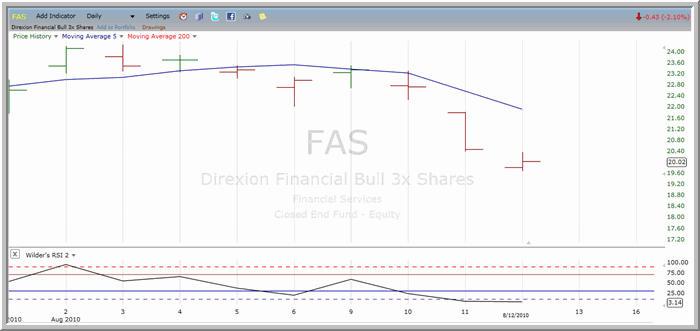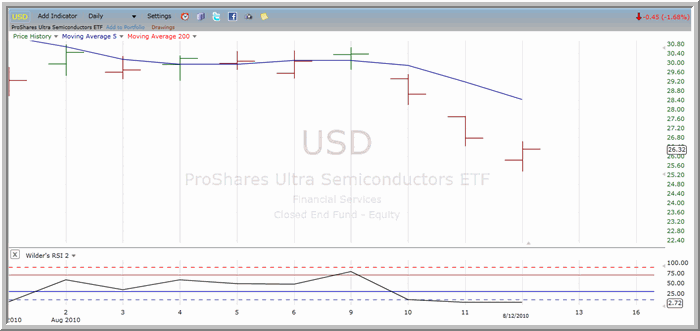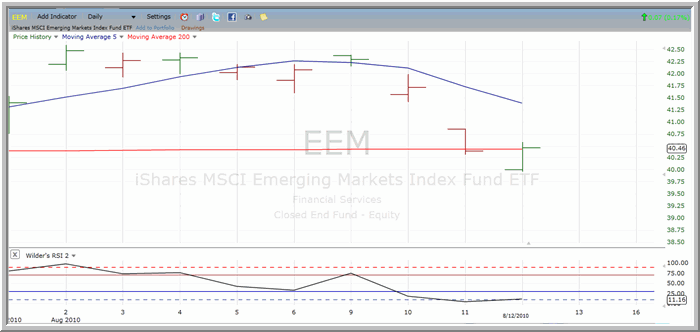High Probability ETF Trading: 7 ETFs You Need to Know (FAS, TYH, USD, EEM, DUG, SSG, XLY)
Thursday’s trading action was notable for a number of reasons. For one, a large number of markets slipped below the 200-day moving average after briefly rallying back above that level. This
includes major exchange-traded funds (ETFs) like the ^SPY^ and the ^QQQQ^.
But second, and perhaps just as importantly, markets rallied all day on Thursday after a gapping down at the open. This, alone, is a relatively bullish indication of traders looking to pounce on significantly oversold conditions on an intraday basis.
What does this mean for high probability traders? Neither of these details should change the methodology of buying the selling and selling the buying, the prime directive of high probability
trading. One of the great things about trading with high probability trading strategies, especially for exchange-traded funds, is that the strategies provide quantified, consistent guidance for
traders regardless of market conditions. The flexibility provided by exchange-traded funds, including leveraged and inverse leveraged ETFs, only makes these strategies that much more potentially
worthwhile for traders looking to find the best ETFs to trade every day.
Let’s take a look at 7 ETFs You Need to Know for the next few days.
Closing lower for three days in a row and moving deeper into oversold territory is the ^FAS^ (below).

FAS is one of the more oversold of the leveraged ETFs, having closed in oversold territory for the past two consecutive trading days. Both of the two most recent times during which FAS has become this oversold resulted in short term bounces in late June and again in early July.
Selling in technology stocks has helped the ^TYH^ move into oversold territory late in the week. TYH has closed lower for three days in a row, and five out of the past six. The last time TYH had been as oversold as it is currently was during a major decline over the second half of June.
Another example of weakness in technology shares is the pullback in the ^USD^ (below).

USD has also closed lower for three days in a row leading into Friday’s trading. USD was one of the markets that gapped down on Thursday only to close higher. As I noted above, this may be taken by many traders as a positive, bullish signal in the fund going forward.
Note that another way to take advantage of the trading in technology is to sell short overbought, technology-related funds such as the ^SSG^. The SSG has closed higher for three days in a row.
Another overbought market for traders looking to sell short is the ^DUG^. DUG, like SSG, has not only gained for three days in a row, but has also crossed back above its 200-day moving average. Like most ETFs this summer, DUG has oscillated around its 200-day moving average for several weeks.
Today’s report includes two exchange-traded funds are not leveraged. One of those ETFs is the ^EEM^.
EEM fell for two days leading into Thursday’s trading. Thursday, along with the broader market, the ETF opened significantly lower only to rally higher over the course of the trading day. The
rally for the most part recouped the losses from the gap down and sets up the opportunity for follow-through to the upside.

The other non-leveraged ETF is the ^XLY^.
XLY closed just a few cents above its 200-day moving average on Thursday – and was also the beneficiary of the market’s initial drop and reverse. Any weakness almost certainly will take the fund back below its 200-day. But the fact that the ETF opened at its lowest levels and closed at its highest will likely be taken as a positive indication by many traders.
High Probability ETF Trading Trading Tip:
For traders trading exchange-traded funds in restricted accounts, such as 401(k) accounts, in which short selling trades are not possible, inverse and inverse leveraged exchange-traded funds can be an excellent alternative. For example, rather than selling short the SPDR S&P 500 Trust ETF on a given day, a trader could buy the ^SH^ or a half-sized position in an inverse leveraged ETF like the ^SDS^.
With Larry Connors’ High
Probability ETF Trading Software, short term traders have access to the same kind of “buy the selling, sell the buying” trading strategies that professional traders have used successfully for decades.
Click
here to start your free trial to Larry Connors’ High Probability ETF Trading Software today!
David Penn is Editor in Chief at TradingMarkets.com.
